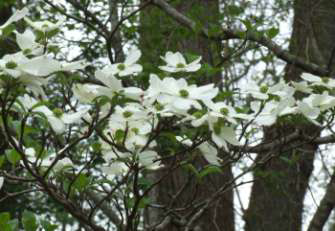 Flowering Dogwood
Flowering Dogwood
(Cornus florida L.)
|
Classification |
| Kingdom: |
Plantae |
| Division: |
Magnoliophyta |
| Class: |
Magnoliopsida |
| Order: |
Cornales |
| Family: |
Cornaceae |
| Genus: |
Cornus |
| Species: |
florida L. |
Characteristics: The Flowering Dogwood is a relatively small tree, reaching heights of 30 feet and trunk diameters of 8 inches. The rough bark is a reddish-brown color. The leaves are opposite and elliptical, approximately 2.5 to 5 inches long and 1.5 to 2.5 inches wide, with slightly wavy edges. The flowers are 3/8 of an inch in diameter and are greenish yellow. These are surrounded by four white petal-like bracts, approximately 1.5 inches long. The bright red, berry-like fruit form in clusters and are about 3/8 to 5/8 of an inch in diameter.
Range: Flowering dogwood is widely dispersed throughout the eastern United States.
Habitat: It tolerates both moist and dry soils of valleys and uplands; it can also be found in fields and along road sides. This deciduous tree is well adapted for the forest understory. It can tolerate conditions that range from full shade to almost full sun.
Native American Uses: The bark and the roots were used as a remedy for malaria and a red dye was extracted from the roots. A tonic was made from the roots and root infusions were consumed as an antidiarrheal, a blood purifier, and a tonic. Also, the flowering dogwood was used as a decoration and for making tools. Shredded bark from the twigs was used to whiten the teeth. The Creoles of Virginia, the Cherokee, Delaware, and Rappahannock Indians are among the Native American tribes known to have utilized this species.
Colonial Uses: Colonial Americans drank a tea brewed from the bark to reduce fevers. In addition, dogwood braches were used to dry fish by the farmers because of the branching pattern of its limbs.
Modern Uses: The flowering dogwood is widely planted for its showy spring flowers and brilliant red fall foliage. In addition, the extremely hard wood is dense, compact and fine-grained, and is used for the construction of commercial loom shuttles and spindles. Old Southern folklore even says that Jesus was crucified on a cross that was made from dogwood, which at the time grew as large as oak trees, but that because of Jesus’ suffering the berries turned bright red and the tree ceased to grow tall and straight.